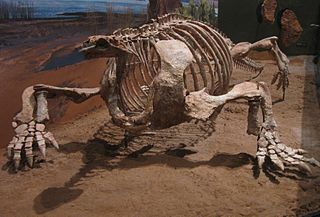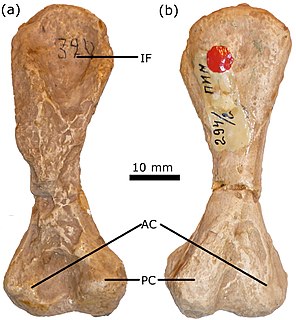
Caseasauria is one of the two main clades of early synapsids, the other being the Eupelycosauria. Caseasaurs are currently known only from the Late Carboniferous and the Permian, and include two superficially different families, the small insectivorous or carnivorous Eothyrididae, and the large, herbivorous Caseidae. These two groups share a number of specialised features associated with the morphology of the snout and external naris.

Ophiacodon is an extinct genus of synapsid belonging to the family Ophiacodontidae that lived from the Late Carboniferous to the Early Permian in North America and Europe. The genus was named along with its type species O. mirus by paleontologist Othniel Charles Marsh in 1878 and currently includes five other species. As an ophiacodontid, Ophiacodon is one of the most basal synapsids and is close to the evolutionary line leading to mammals.

Mycterosaurus is an extinct genus of synapsids belonging to the family Varanopidae. It is classified in the varanopid subfamily Mycterosaurinae. Mycterosaurus is the most primitive member of its family, existing from 290.1 to 272.5 MYA, known to Texas and Oklahoma. It lacks some features that its advanced relatives have.

Varanops is an extinct genus of Early Permian varanopid synapsids known from Texas and Oklahoma of the United States. It was first named by Samuel Wendell Williston in 1911 as a second species of Varanosaurus, Varanosaurus brevirostris. In 1914, Samuel W. Williston reassigned it to its own genus and the type species is Varanops brevirostris.
Casea is an extinct genus of medium to large-bodied, herbivorous, pelycosaur synapsids from the late Carboniferous until the middle Permian. The name Casea references its appearance from the Caseasauria which developed new morphology of their external naris and snout. Casea were known to be about 1.2 meters long. It weighed between 150 kg to 200 kg. It was slightly smaller than the otherwise very similar Caseoides. Casea was one of the first amniote herbivores, sharing its world with animals such as Dimetrodon and Eryops. It was possibly also aquatic.

Oedaleops is an extinct genus of caseasaur synapsids from the Early Permian of the southwestern United States. Fossils have been found in the Cutler Formation in New Mexico, which dates back to the Wolfcampian stage of the Early Permian. All remains belong to the single known species Oedaleops campi. Oedaleops was closely related to Eothyris, and both are part of the family Eothyrididae. Like Eothyris, it was probably an insectivore.

Cotylorhynchus is an extinct genus of very large synapsids that lived in the southern part of what is now North America during the Early Permian period. It is the best known member of the synapsid clade Caseidae, usually considered the largest terrestrial vertebrates of the Early Permian, though they were possibly aquatic.

Colobomycter is an extinct genus of lanthanosuchoid parareptile known from the Early Permian of Oklahoma.

Aerosaurus is an extinct genus within Varanopidae, a family of non-mammalian synapsids. It lived between 252-299 million years ago during the Early Permian in North America. The name comes from Latin aes (aeris) “copper” and Greek sauros “lizard,” for El Cobre Canyon in northern New Mexico, where the type fossil was found and the site of former copper mines. Aerosaurus was a small to medium-bodied carnivorous synapsid characterized by its recurved teeth, triangular lateral temporal fenestra, and extended teeth row. Two species are recognized: A. greenleeorum (1937) and A. wellesi (1981).
Elliotsmithia is a small varanopid synapsid found from the late Middle Permian of South Africa. It is the sole basal synapsid "pelycosaur" known from the supercontinent Gondwana and only two specimens have been yielded to date. Its species name longiceps is derived from Latin, meaning "long head". Both known Elliotsmithia fossils were recovered from Abrahamskraal Formation rocks—within the boundaries of the Tapinocephalus Assemblage Zone—of the lower Beaufort Group.

Phreatophasma is an extinct genus of synapsids from the Middle Permian of European Russia. It includes only one species, Phreatophasma aenigmatum, which is itself known from a single femur found in a mine near the town of Belebei in Bashkortostan. Phreatophasma comes from a fossil assemblage that is latest Ufimian to earliest Kazanian in age under the Russian stratigraphic scheme, correlating with the Roadian Age under the international stratigraphic timescale. Because the species is based on a single specimen with few diagnostic anatomical features, uncertainty remains as to where it belongs in tetrapod phylogeny; originally interpreted in 1954 as an enigmatic "theromorph" synapsid by Soviet paleontologist Ivan Yefremov, Phreatophasma was later described as a therapsid incertae sedis by American paleontologist Alfred Romer in 1956 and then as a member of a basal synapsid family called Caseidae starting with Everett C. Olson in 1962. Olson's classification was later supported by Canadian paleontologist Robert Reisz in 1986 and American paleontologist Robert L. Carroll in 1988. Ivakhneneko et al. (1997) and Maddin et al. (2008) both considered Phreatophasma an indeterminate synapsid.

Tetragonias is an extinct genus of non-mammalian synapsid from the Anisian Manda Beds of Tanzania. Tetra- means “four,” and goni- means “angle,” referencing the square shape of the Tetragonias skull when viewed dorsally. Not to be confused with Tetragonia,Tetragonias were dicynodont anomodonts discovered in the late 1960s by paleontologist A. R. I. Cruickshank in the Manda Formation.

Acleistorhinus (ah-kles-toe-RYE-nuss) is an extinct genus of parareptile known from the Early Permian of Oklahoma. It is notable for being the earliest known anapsid reptile yet discovered. The morphology of the lower temporal fenestra of the skull of Acleistorhinus bears a superficial resemblance to that seen in early synapsids, a result of convergent evolution. Only a single species, A. pteroticus, is known, and it is classified in the Family Acleistorhinidae, along with Colobomycter.
Pasawioops is an extinct genus of early Permian dissorophoid temnospondyl within the clade Amphibamiformes.

Rubeostratilia is an extinct genus of amphibamiform temnospondyl from the early Permian of Texas. It is known from a single skull. This genus was named by Hélène Bourget and Jason S. Anderson in 2011, and the type species is Rubeostratilia texensis. The genus name comes from the Latin translation of 'redbeds' in reference to the Texas redbeds that produced both the holotype and many other early Permian fossils. The species name is for the state of Texas. The holotype and only known specimen was collected in 1941 from the Nocona Formation exposures in Clay County by a Works Projects Administration project that was transferred to the Field Museum of Natural History through an interinstitutional exchange with the Texas Memorial Museum.
Plemmyradytes is an extinct genus of dissorophoid temnospondyl from the early Permian. It is an amphibamiform from the Eskridge Formation exposures of Nebraska. The type species is Plemmyradytes shintoni. The genus name derives from the Greek plemmyris and dytes ('diver'), while the species name honors John Shinton, a fossil preparator at the Denver Museum of Natural History where all known specimens of this taxon are reposited following collection in the late 20th century.

Euromycter is an extinct genus of medium-sized caseid synapsids from Early (Artinskian-Kungurian) or Middle (Roadian-Wordian) Permian deposits of Southern France. The holotype and only known specimen of Euromycter (MNHN.F.MCL-2) includes the complete skull with lower jaws and hyoid apparatus, six cervical vertebrae with proatlas, anterior part of interclavicle, partial right clavicle, right posterior coracoid, distal head of right humerus, left and right radius, left and right ulna, and complete left manus. It was collected by D. Sigogneau-Russell and D. Russell in 1970 at the top of the M1 Member, Grès Rouge Group, near the village of Valady, Rodez Basin. It was first assigned to the species "Casea" rutena by Sigogneau-Russell and Russell in 1974. More recently, it was reassigned to its own genus, Euromycter, by Robert R. Reisz, Hillary C. Maddin, Jörg Fröbisch and Jocelyn Falconnet in 2011. The preserved part of the skeleton suggests a size between 1,70 m (5,5 ft) and 1,80 m (5,9 ft) in length for this individual.

Richards Spur is a Permian fossil locality located at the Dolese Brothers Limestone Quarry north of Lawton, Oklahoma. The locality preserves clay and mudstone fissure fills of a karst system eroded out of Ordovician limestone and dolostone, with the infilling dating to the Artinskian stage of the early Permian (Cisuralian), around 289 to 286 million years ago. Fossils of terrestrial animals are abundant and well-preserved, representing one of the most diverse Paleozoic tetrapod communities known. A common historical name for the site is Fort Sill, in reference to the nearby military base. Fossils were first reported at the quarry by workers in 1932, spurring a wave of collecting by local and international geologists. Early taxa of interest included the abundant reptile Captorhinus and microsaurs such as Cardiocephalus and Euryodus. Later notable discoveries include Doleserpeton, the most diverse assortment of parareptiles in the Early Permian, and the rare early diapsid Orovenator.
Hillary Catherine Maddin is a Canadian paleontologist and developmental biologist known for her work on development in extinct and extant amphibians. She is currently an associate professor in the Department of Earth Sciences at Carleton University.


















